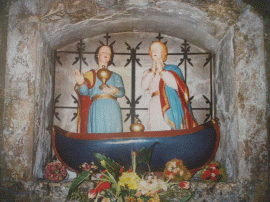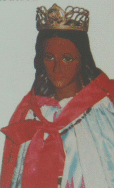The Camargue Secret

- SUBSCRIBE
- ALREADY SUBSCRIBED?
BECOME A BONJOUR PARIS MEMBER
Gain full access to our collection of over 5,000 articles and bring the City of Light into your life. Just 60 USD per year.
Find out why you should become a member here.
Sign in
Fill in your credentials below.
The Camargue Secret (with respect to Dan Brown!)
– by Chris Cobb
The job of any writer, in my opinion, is to stimulate the imagination of his reader. Dan Brown certainly stimulated mine while I was reading The Da Vinci Code, and it got me thinking about some things I’d learned while living in the Camargue wilderness in the south of France.
With hindsight, I should have guessed that I would be given insights not usually associated with your average "tourist trap.”Recuperating from clinical depression, I had just completed the healing process by travelling alone more than one thousand miles in my tiny motorboat "Sky,” traversing the canals of the UK and France, and finally motoring out into the blue Mediterranean Sea at 15:20hrs, on Tuesday, 16th September 1997.
To say that that was an emotional moment for me would be an understatement, and I drifted on the water for a while, just quietly accepting that I had achieved something remarkable for once in my life. I looked around at the kaleidoscope of twinkling miniature suns reflecting off the surface of the Mediterranean and I was pleased. Behind me was another life, and ahead of me, in the distance, under a blue, blue sky, beckoned the little  sunbleached village of Les Saintes-Maries-de-la-Mer.
sunbleached village of Les Saintes-Maries-de-la-Mer.
Now it has taken me over five years to appreciate the marvels of this village known as "Les Saintes", so please be patient if I paint you a pictorial, social background for the thesis I would like to share with you.
Now it has taken me over five years to appreciate the marvels of this village known as "Les Saintes", so please be patient if I paint you a pictorial, social background for the thesis I would like to share with you.
Sky and I quietly entered Port Guardian, passing a welcome sign, "Bienvenue aux Saintes-Maries-de-la-Mer," and under direction from a port employee we moored up at our new home. (How different this was from the welcome afforded to the saintly personalities we will meet in this article.) The church was the first thing I saw on arrival, as local building regulations impose height restrictions on all buildings in the village, with the exception (interestingly enough) of a townhouse built recently by one of the town’s mayors. The church tower, however, rises high above the rooftops, and its five distinctive bells can be seen from miles away.
This church is the focus of two major annual pilgrimages, one a Christian celebration and the other a gypsy festival. But what brings pilgrims from all over the world to this humble venue? The Breviary of the diocese of Aix records that Mary Jacob, the sister of the Virgin Mary, and Jesus’ aunt, was shipwrecked on the shores of the Camargue delta along with Mary Salome, mother of the "sons of Zebedee", James and John. Both women were made saints in view of their faithfulness to Jesus both during and after his ministry. The Gospels tell that Jesus accepted them as disciples, unlike other rabbis of the time who only accepted male followers (this perhaps also raises the question of the place of women in religion today). All the apostles, save John, hid themselves during the crucifixion, but Mary Jacob and Mary Salome were witnesses, and later, when the stone was rolled away from the entrance to the tomb, Mary Jacob was there with another Mary, Mary Magdalene.
Historically, during that time Christians were being persecuted throughout the Middle East. Indeed, Mary Salome’s son James was executed by Herod Agrippa. The Breviary of Aix states that in Palestine "… Mary Jacob and Mary Salome were arrested and put on a ship with neither sail nor oar which, guided by Providence, found its way to the Provence shore." The two saints spent the rest of their lives spreading Christianity throughout the south of France.
 The Sunday closest to October 22nd is the feast of Mary Salome. And what a day that is! Thousands throng the narrow streets of Les Saintes. The relics of the saints are lowered down from the window of the "Chapelle Haute" in the church, and the excited crowds follow "Les Arlesiènne" ladies in their colourful traditional costumes and the local cowboys ("guardians") on their white horses, who escort the statues of the two Marys down to the brilliant white sandy beach. There they ride out into the sea with the statues to perform a blessing on the waves.
The Sunday closest to October 22nd is the feast of Mary Salome. And what a day that is! Thousands throng the narrow streets of Les Saintes. The relics of the saints are lowered down from the window of the "Chapelle Haute" in the church, and the excited crowds follow "Les Arlesiènne" ladies in their colourful traditional costumes and the local cowboys ("guardians") on their white horses, who escort the statues of the two Marys down to the brilliant white sandy beach. There they ride out into the sea with the statues to perform a blessing on the waves.
Now let’s go back for a moment to The Da Vinci Code by Dan Brown. In the book, he invokes the ancient Chinese Yin/Yang philosophy and relates this to the basic premise of his story. According to Yin/Yang, the universe comprises a balance of opposites, so, using black and white as an example, let us also apply this concept to the two pilgrimages to Les Saintes. We can then see that Black Sarah is surely a balance to the two "white" Marys, whose statues are taken down to the shore, once again, on 25th May, the Feast of Mary Jacob.
 The gypsy festival is even more expansive than that for the two Marys. One year I was fascinated to see a long line in front of a magnificent modern caravan trailer–hundreds of subjects of the King of the Romanies were waiting to kiss the huge jewelled ring on his finger. Thousands of Gypsies come from all over the world, these days mostly in expensive or not so expensive motor cars, but also in traditional horse-drawn caravans. After the ceremony, during which the statue of Sarah is taken out of the church and paraded through the village, it’s party time. Throughout the night there is eating, drinking, guitar-playing, flamenco dancing, and the "guardians" actually riding their white horses wild-west fashion right into the cafés, with a superb firework display at the end of which there is usually an enormous explosion and the most beautiful rose shaped bouquet of lights in the night sky.
The gypsy festival is even more expansive than that for the two Marys. One year I was fascinated to see a long line in front of a magnificent modern caravan trailer–hundreds of subjects of the King of the Romanies were waiting to kiss the huge jewelled ring on his finger. Thousands of Gypsies come from all over the world, these days mostly in expensive or not so expensive motor cars, but also in traditional horse-drawn caravans. After the ceremony, during which the statue of Sarah is taken out of the church and paraded through the village, it’s party time. Throughout the night there is eating, drinking, guitar-playing, flamenco dancing, and the "guardians" actually riding their white horses wild-west fashion right into the cafés, with a superb firework display at the end of which there is usually an enormous explosion and the most beautiful rose shaped bouquet of lights in the night sky.
So. Black Sarah. Where did the young patron saint of the Gypsies come from? Well, there are several traditions relating to her. One says that she was the servant of the two Marys and came with them in the boat from Palestine. Another that she was from the Camargue, born into a noble race and queen of her tribe. Others place her origin in Egypt, Libya and even Persia.
Now we are coming to the crunch, indeed the moment when your patience will be rewarded. What I have not told you yet is that there was another Mary on the boat–Mary Magdalene. There can be no doubt that she arrived with Mary Salome and Mary Jacob, along with Lazarus, his sister Martham and others, and that she spent the latter part of her life in Provence, but this fact is kept very low key in all the tourist literature. Locals, however, keep her memory alive in various ways. For example, a friend of mine, Christophe Valette, has two tourist boats named "Les Quatres Maries" (1 & 2). "The Four Marys" refers to the Virgin Mary, along with Mary Salome and Mary Jacob, but also to Mary Magdalene.
Historical fact cannot be denied, and even Mr Brown says that Mary Magdalene came to France from Palestine. However, the origin of the patron saint of Gypsies is not known. In conclusion, may I now offer you some clues?
1. Yin/Yang can be displayed as black and white. But, if we look at a photo of the statue of Sara-la-Kâli, we see that she is not really portrayed as "black" and the two Saint Marys were not "white" but probably had typically dark middle-eastern features.
2. Quote from The Da Vinci Code:"White gives birth to black."
3. Quote from The Da Vinci Code: "It was here in France that she (Mary Magdalene) gave birth to a daughter. Her name was Sarah."
P.S. I have never been happy with the ending of Dan Brown’s otherwise exciting book, so if you’re hunting for the real hiding place of the "Holy Grail", like Dan Brown’s hero, why not come to "La Camargue" and then follow the travels of Mary Magdalene. But where did she go to in Provence after leaving Les-Saintes-Maries-de-la-Mer? And watch out for the "guardians"!
1. Yin/Yang can be displayed as black and white. But, if we look at a photo of the statue of Sara-la-Kâli, we see that she is not really portrayed as "black" and the two Saint Marys were not "white" but probably had typically dark middle-eastern features.2. Quote from The Da Vinci Code:"White gives birth to black."
P.P.S. Two-time Academy Award winner Tom Hanks has recently been cast in the lead role of Robert Langdon in Columbia Pictures’ upcoming film adaptation of The Da Vinci Code. Columbia has announced May 19, 2006 as the release date and Variety is reporting that Sir Ian McKellen will play Sir Leigh Teabing.
They probably still have time to change the ending.


